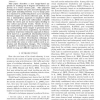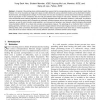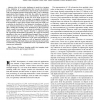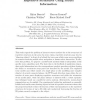VLUDS
2010
13 years 9 months ago
2010
Stereo matching algorithms and multi camera reconstruction algorithms are usually compared using benchmarks. These benchmarks compare the quality of the resulting depth map or rec...
TCSV
2010
13 years 9 months ago
2010
Abstract--Real-time stereo vision is attractive in many applications like robot navigation and 3D scene reconstruction. Data parallel platforms, e.g. GPU, is often used for real-ti...
IJRR
2010
13 years 9 months ago
2010
Abstract-This paper describes a new image-based approach to tracking the 6 degrees of freedom trajectory of a stereo camera pair. The proposed technique estimates the pose and subs...
PAMI
2011
13 years 9 months ago
2011
—A majority of the existing stereo matching algorithms assume that the corresponding color values are similar to each other. However, it is not so in practice as image color valu...
TIP
2011
13 years 9 months ago
2011
—One of the major challenges in multi-view imaging is the definition of a representation that reveals the intrinsic geometry of the visual information. Sparse image representati...
CVPR
2011
IEEE
13 years 10 months ago
2011
IEEE
This paper presents a method for joint stereo matching and object segmentation. In our approach a 3D scene is represented as a collection of visually distinct and spatially cohere...
ICIP
2010
IEEE
14 years 12 days ago
2010
IEEE
This paper proposes a statistical rejection rule, designed for small baseline stereo satellites. The method learns an a contrario model for image blocks and discards the casual ma...
ICIP
2010
IEEE
14 years 12 days ago
2010
IEEE
Segmentation-based approach has shown significant success in stereo matching. By assuming pixels within one image segment belong to the same 3D surface, robust depth estimation ca...
PRL
2010
14 years 25 days ago
2010
This study regards the problem of incorrect stereo matches due to the occurrence of repetitive structures in the scene. In stereo vision, repetitive structures may lead to “phan...
ICRA
2010
IEEE
14 years 29 days ago
2010
IEEE
— Passive stereo vision is widely used as a range sensing technology in robots, but suffers from dropouts: areas of low texture where stereo matching fails. By supplementing a st...




